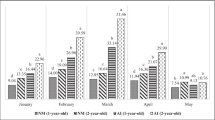Abstract
The role of males in fertilization in the rotifer Brachionus plicatilis was examined. Neonate mictic females sometimes escaped fertilization even when sperm were present in their pseudocoeloms. Males made a major contribution to this fertilization failure through temporary infertility. As males aged, sperm numbers and motility decreased. Maternal diet was found to play a primary role in determining the fertilizing capacity of the F1 males. Females from log phase populations produced males with higher sperm counts and motility than females from stationary phase populations. A conditioning factor in the medium may increase sperm number and fertilization rate.
Similar content being viewed by others
References
Buchner, H., C. Mutschler & H. Kiechle, 1967. Die Determination der Mannchen- und Dauereiproduktion bei Asplanchna sieboldi. Biol. Zbl. 86: 599–621.
Gilbert, J. J., 1963. Contact chemorecption, mating behavior, and sexual isolation in the rotifer genus Brachionus. J. exp. Biol. 40: 625–641.
Gilbert, J. J., 1983. Rotifera. In: Reproductive Biology of Invertebrates. Vol. II: Spermatogenesis and Sperm Function. K. G. Adiyodi & R. G. Adiyodi (eds.), John Wiley & Sons, New York, pp. 181–193.
Gulliard, R. R. L., 1983. Culture of phytoplankton for feeding marine invertebrates. In: C. J. Berg, Jr. (ed.), Culture of Marine Invertebrates. Hutchinson-Ross, Stroudsberg, PA, pp. 108–132.
Koehler, J. K., 1965. An electron microscope study of the dimorphic spermatozoa of Asplanchna (Rotifera). I. The adult testis. Z. Zellforsch. 67: 57–76.
Koehler, J. K. & C. W. Birky Jr., 1966. An electron microscope study of the dimorphic spermatozoa of Asplanchna (Rotifera). II. The development of ‘atypical spermatozoa’. Z. Zellforsch. 70: 303–321.
Ruttner-Kolisko, A., 1983. The significance of mating processes for the genetics and for the formation of resting eggs in monogonont rotifers. Hydrobiologia 104: 181–190.
Ruttner-Kolisko, A., 1985. Results of individual cross-mating experiments in three distinct strains of Brachionus plicatilis (Rotifera). Verh. int. Ver. Limnol. 22: 2979–2982.
Snell, T. W. & C. A. Hawkinson, 1983. Behavioral reproductive isolation among populations of the rotifer Brachionus plicatilis. Evolution 37: 1294–1305.
Whitney, D. D., 1917. The production of functional and rudimentary spermatozoa in rotifers. Biol. Bull. 33: 305–315.
Author information
Authors and Affiliations
Rights and permissions
About this article
Cite this article
Snell, T.W., Hoff, F.H. Fertilization and male fertility in the rotifer Brachionus plicatilis . Hydrobiologia 147, 329–334 (1987). https://doi.org/10.1007/BF00025762
Issue Date:
DOI: https://doi.org/10.1007/BF00025762




